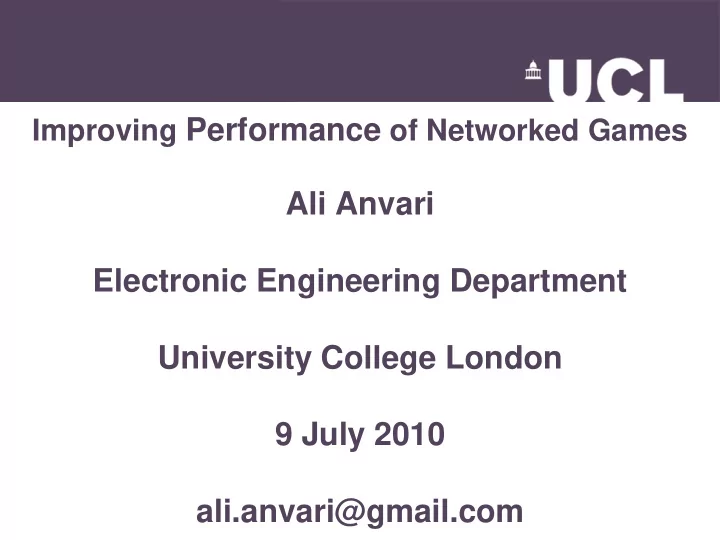

Improving Performance of Networked Games Ali Anvari Electronic Engineering Department University College London 9 July 2010 ali.anvari@gmail.com
Example of a game: Tank Deathmatch “ Battlezone ” (Atari), fetched from Photobucket.com ( benchilada)
Overview of Games Game state (tank positions, armour rating, ammunition) Feedback of game state to player (camera position) Updates of state by players (push joysticks, drive tanks) Processing of interactions (collisions, shooting) Transient state (bullets) Long-lived state (walls, mountains, moon)
Bandwidth needed grows with # of players Toeach of n game clients player Send data (graphics, sound) about target Foreach of N game objects target So the game design is not strictly networking, yet still impacts the network Too many objects could overwhelm client bandwidth
LAN games exception handling for load: State of the art: The server falls over Delays could cause clients to freeze up So every client with consistently slow latency is ejected Clients lacking bandwidth get backlogged packets Backlog -> Lag -> Ejection by server LAN servers dimensioned for 128 players +/- factor of 2 (Donnybrook claims 900)
Try to solve with Interest Management Don’t need to process game entities too far away to interact with (tanks out of range) Don’t need to process game entities too far away to observe (tanks disappear into dots on horizon) Don’t need to track changes of game entities that don’t change (mountains, wall, moon constant, indestructible) Geographic Interest Management.
Problems moving from LAN to Internet Latency goes up <10 ms to next room, >200 ms to China Bandwidth goes down Gbps ethernet vs 256 kbps broadband Contention goes up 8 port switch vs 50:1 broadband connection <40 kbps per user (“Developing Online Games” Patrovsky & Mulligan) Player numbers go up <100 in living room, >1 million (World of Warcraft)
Review of Bandwidth Optimization: Geographic Interest Management Send data to client Foreach game object target Foreach game object that moves otherplayer Foreach game object in same room roommate Foreach game object in area of interest neighbour
Area Of Interest: Theory Practice
Sharding: (In case Area Of Interest fails) Slice game up or make “parallel universe” replicas Put each slice on a different server Fix map data as constant for each slice Allocate a certain number of players to each slice
Sharding Theory Practice
Players have reason to gather in same area (So reduce Sharding, it ruins experience) “Return of the Jedi” (20th Century Fox), screengrab
Density Based Interest Management: VELVET proposal (de Oliveira) Send data to client Foreach of k nearest neighbours NN Implemented by changing size of area of interest Increase area of interest for clients with more bandwidth, Decrease area of interest for clients with less bandwidth Increase area of interest for zones with few players, Decrease area of interest for zones with many players Peer to peer to avoid server bottlenecks
Unanswered Questions If the bottleneck is at the clients (40 kbps), why dump server workload on them by using P2P? • Will not consider further How to calibrate area of interest for client bandwidth? How to calibrate area of interest for player density?
N 2 problem to calculate distances, densities Standard solution is Spatial Indexing (NLogN), But maintaining the Spatial Index is expensive As player positions change, Index must be rebalanced Rebalancing cost can be high (millions of users) Spatial Index is a global bottleneck for central server
Spatial Indexes based on Space Partitioning Rebalance when objects cross partition boundaries For more details, see literature on BSP Trees, RTrees
Spatial Indexing State Of The Art EVE online Only 2 shards Up to 700 players per battle 60,000 peak users in a shard Far smaller than World of Warcraft 200 node supercomputer with high speed interconnect, solid state drives
Seamless Servers (Beardsley) Need to keep entries for objects in multiple partitions But: Less rebalancing needed?
Problems with bandwidth adaptation Standard method is congestion control as in TCP Additive Increase, Multiplicative Decrease Feedback (ACKs) based on Round Trip Time Games run at high frequency Upward of 20 frames per second Less than100 ms for each transmission or game fails Congestion control must finish in this time Internet servers have high latency Server processing, ISP peering, Speed of light More than100 ms before Feedback arrives Not enough time for standard congestion control
How to make bandwidth adaptation work in real time? (Suggestions Welcome!) Network measurements of access network from ISP? Game server bandwidth control to be run in ISP network? In local exchange? DiffServ? LEDBAT? Congestion control if low latency, else assume worst case?
Summary Area Of Interest used to reduce bandwidth, CPU load in LAN games. Overwhelmed at Internet Scale (especially by Flash Mobs) It has been proposed to scale AOI based on player Density, client Internet Bandwidth. Open Questions: 1. How to calculate player density in real time? 2. How to adapt bandwidth usage in real time?
Questions? Suggestions? “Return of the Jedi” (20th Century Fox), screengrab
Recommend
More recommend